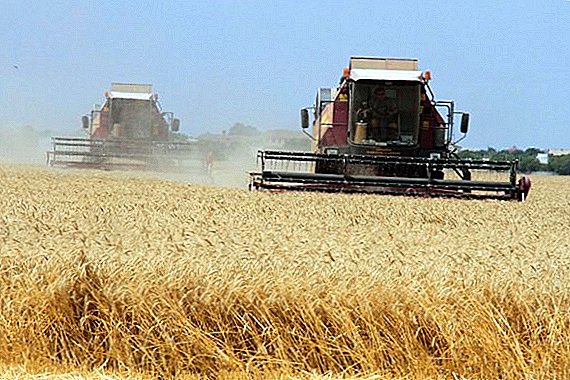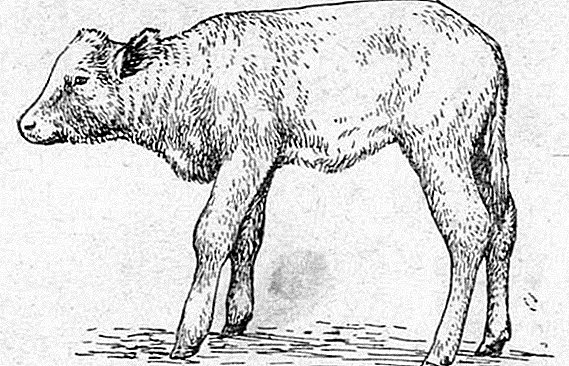 Modern farmers regularly encounter problems with the emergence of a variety of diseases in animals raised on their farms.
Modern farmers regularly encounter problems with the emergence of a variety of diseases in animals raised on their farms.
This article will discuss one of the most dangerous infectious diseases - salmonellosis, and its manifestations during infection of young calves.
What is this disease
Calves' salmonellosis is an infectious disease, the causative agent of which is Salmonella Dublin bacterium, which occurs in an acute form in the form of damage to the organs of the digestive tract and the immune response system, and in the chronic form also affects the lungs. Moreover, violations are often reversible. Symptoms regress can be achieved using a variety of antibacterial, nonsteroidal anti-inflammatory and disinfectants.
Did you know? Salmonellosis is a disease that affects not only artiodactyls and humans, it is also dangerous for cats, dogs, horses, pigs, certain types of poultry and even fish!
Causative agent and causes of infection
The causative agent of this disease, Salmonella Dublin, belongs to the genus Salmonella bacteria, which are shaped like rods, do not have the ability to digest milk protein and cause various pathological conditions when ingested in a human or animal body. This bacterium does not tolerate the effects of sunlight and dies when exposed to high temperatures. Freezing is not fatal to these microorganisms.  The causative agents of salmonellosis are able to persist in the environment, especially in food, for a very long time. Most often, they enter the body of the calf in the alimentary way, that is, with contaminated food or water, sometimes through poorly treated drinkers and feeders. It is also often the case that in the process of feeding a cub, an adult cow gives it the causative agent of the disease with milk (in the event that she herself is infected with salmonella) or through a contaminated udder.
The causative agents of salmonellosis are able to persist in the environment, especially in food, for a very long time. Most often, they enter the body of the calf in the alimentary way, that is, with contaminated food or water, sometimes through poorly treated drinkers and feeders. It is also often the case that in the process of feeding a cub, an adult cow gives it the causative agent of the disease with milk (in the event that she herself is infected with salmonella) or through a contaminated udder.
Important! Salmonellosis can be transmitted from cow to man through milk, therefore the process of milking them is recommended to be done with gloves and from time to time milk should be tested.
The main cause of infection of young calves by the disease in question is the failure to comply with the relevant hygienic standards in the premises where they are kept. The insufficiently scrupulous examination of cows before calving, the uncontrolled use of antibacterial agents (including without completing a complete regimen of admission), which results in the formation of bacteria resistant to treatment, as well as the fact of the possibility of cross-infection with other animal species and humans, also plays an important role.
Forms and symptoms
This pathology is characterized by the presence of several different forms, differing in the severity of pathological changes, the severity of the animal's condition, the likely consequences and the necessary treatment. In order to know exactly what you should do in the event of the onset of symptoms of this disease in your wards, you must first carefully study all possible forms of its manifestation.  Damage to the limb joints of the calf with paratyphoid fever
Damage to the limb joints of the calf with paratyphoid fever
Acute form
Symptoms of the acute form of the described disease occur over a rather short period of time. It may happen that in the morning your calf will show normal behavior, and in the evening he will develop an extensive clinical picture of the disease, which will require the intervention of a specialist.
Read more about the dangerous diseases of calves.
The acute form of the disease can be completely cured or become chronic, it depends on the intensity of treatment, its success and the individual characteristics of the organism of the diseased animal. Here is a list of symptoms of acute salmonellosis:
- high body temperature;
- decrease in the vitality of the animal;
- changes in behavior (excessive irritability or, on the contrary, calm);
- refusal to eat and drink;
- cardiac abnormalities (arrhythmias, increased heart rate);
- serous conjunctivitis;
- lacrimation;
- excessively loose stools with streaks of mucus and blood more than 5 times a day.
 In the event that the disease occurs in especially severe forms, by the third day after its onset, problems with kidney function may also begin in the sick animal: the number of urination increases, they begin to cause inconvenience, and the amount of urine decreases. If this form of salmonellosis is not treated properly, it will be fatal for the calf in 5-10 days.
In the event that the disease occurs in especially severe forms, by the third day after its onset, problems with kidney function may also begin in the sick animal: the number of urination increases, they begin to cause inconvenience, and the amount of urine decreases. If this form of salmonellosis is not treated properly, it will be fatal for the calf in 5-10 days.
Learn how to measure body temperature in cattle.
Subacute form
It is characterized by the development of symptoms, which completely repeats the whole range of signs of the acute form, but at the same time it is much less pronounced and painful for the animal.
In many ways, the course of the subacute form is reminiscent of the chronic, but it does not affect the respiratory organs, and the inflammatory processes are still more pronounced. The subacute form of this disease can develop in these animals in several cases:
- if the calf by nature has a very well-developed immunity to this strain of bacteria;
- if the bacterium is ingested in a sufficiently small amount (less than 100,000 bacteria at a time);
- if the calf was vaccinated against salmonellosis, but the inoculation was not of sufficient quality;
- if the animal has this disease is not the first time;
- if the cow who gave birth to the calf was ill with the disease in question during pregnancy.
 The subacute form, unlike the acute form, is characterized by a pronounced tendency to chronicity, since very often the owners of animals, observing the fact that animals do not show more signs of the disease, stop giving them the necessary medications. This leads to the formation of resistant and unproductive strains of bacteria that are very difficult to cure in the future.
The subacute form, unlike the acute form, is characterized by a pronounced tendency to chronicity, since very often the owners of animals, observing the fact that animals do not show more signs of the disease, stop giving them the necessary medications. This leads to the formation of resistant and unproductive strains of bacteria that are very difficult to cure in the future.
Chronic
This form of the disease can not be formed as a primary, it must necessarily be preceded by an acute or subacute episode. As a result of the summation of a variety of various factors (the state of the calf's immune system, its conditions of detention, the correctness of treatment, etc.), after suffering the acute part of the disease, either complete recovery or its transition to a chronic form is possible.
Did you know? Salmonella toxin, which has a major destructive effect on the body of a sick animal, is called TTSS-1 and is produced only by those bacteria that cover the intestinal walls, and are not in its lumen.
Sometimes the chronic form of the disease can only suggest bacteriocarrier, without a variety of clinical manifestations, but more often its symptoms include:
- minor disorders of the gastrointestinal tract;
- discharge of mucus from the nose, often with a purulent component;
- wet, loud, very frequent cough;
- slow rise in body temperature to subfebrile marks;
- weakness, reduced vitality of the animal;
- refusal of food and drink;
- changes in behavior (excessive activity or, on the contrary, lethargy);
- sometimes an increase in size and soreness of large joints.

Important! Chronically sick with salmonellosis of cows after several unsuccessful attempts of treatment it is customary to slaughter. The meat of such cows is suitable for food after proper heat treatment.
Diagnostics
Salmonellosis can be diagnosed in several ways. The first of these, the most frequently used and the simplest, is a comparison of the visible state of the animal with the known symptoms of the intended disease. However, it is not recommended to use this technique for those who have never seen animals with salmonellosis, because of its subjectivity. In addition, this method of diagnosis often leads to errors, since there are many other intestinal infections with very similar symptoms.  A more reliable method of diagnosis is the analysis of the blood and feces of an animal under laboratory conditions using ELISA, PCR, chromatography, or during studies of the cultural properties of bacterial colonies that are planted on Petri dishes. This method allows you to almost completely eliminate the likelihood of erroneous diagnosis and reasonably prescribe treatment.
A more reliable method of diagnosis is the analysis of the blood and feces of an animal under laboratory conditions using ELISA, PCR, chromatography, or during studies of the cultural properties of bacterial colonies that are planted on Petri dishes. This method allows you to almost completely eliminate the likelihood of erroneous diagnosis and reasonably prescribe treatment.
In addition, in the course of studies of cultural properties, it is also possible to measure the sensitivity of bacteria to a variety of antibacterial drugs, which will help to choose a more adequate treatment for sick calves.
Pathological changes
The most accurate way to confirm the diagnosis of salmonellosis is an autopsy examination of an animal that has died during the course of the disease. Conducting such a study is necessary to exclude the possibility of infection of other animals through common household items, places of detention and food supply with the deceased.
Important! If the diagnosis of salmonellosis is confirmed pathoanatomically, then it is necessary to carry out the processing of all objects with which the deceased animal has come in contact, and its stalls, and also to check on this pathology his mother and all the colleagues who have contacted him.Most often at the autopsy for salmonellosis, bloating and overflow of the intestine with toxic contents, mainly of a serous purulent character, with rare inclusions of normal feces, as well as local inflammation of the lymph nodes and vessels adjacent to the intestine are noted. In more advanced cases, signs of sepsis are noted. When death from a chronic form of the disease, which is extremely rare, you can also find changes in the structure of the lung tissue - the presence of inflammatory foci in the lung parenchyma and signs of bronchitis.
Methods of struggle and treatment
Before proceeding with medical treatment, sick calves are isolated in a room with a comfortable temperature and an adequate area. The treatment itself sets several tasks at once - it is the destruction of bacteria, the normalization of the processes of digestion and metabolism, the removal of the intoxication syndrome, and in the case of a chronic course - the restoration of normal breathing function.  Modern therapy of the considered pathology involves the use of a combination of several drugs - antibiotics, antitoxic serum, as well as symptomatic drugs (sorbents, antipyretic, antitussive, disinfectants, etc.).
Modern therapy of the considered pathology involves the use of a combination of several drugs - antibiotics, antitoxic serum, as well as symptomatic drugs (sorbents, antipyretic, antitussive, disinfectants, etc.).
Antibiotics
Antibacterial drugs can be used in the treatment of salmonellosis as monotherapy, however, additional complications may develop due to the release of additional portions of toxins by bacteria during their death. When antibiotics are used in combination with antitoxic serum, the likelihood of such a development is significantly reduced.
Read about antibiotics for cows that are used in modern veterinary medicine.
The list of antibiotics most recommended by veterinarians for the treatment of salmonellosis:

- chlorotetracycline hydrochloride. Give 3 times a day, in / m, at the rate of 0.02 g per 1 kg of body weight of the calf;
- "Sintomitsin". To drink, mixing together with milk, 3 times a day, in the morning at 0.04 g per 1 kg of body weight, and for the remaining two feedings - at 0.02 g per 1 kg of weight;
- sulfonamides (only in combination with other antibiotics). Give 4 times a day, in / m, at the rate of 0.025 g per 1 kg of animal body weight;
- nitrofurans. Feeding with milk, 3 times a day, 0.25 g per feeding;
- "Clamoxyl LA". Enter subcutaneously or intramuscularly, at a dosage of 1 milliliter for every 10 kilograms of the weight of the sick animal;
- "Terramycin LA". Introduced deeply intramuscularly, 1 ml for every 10 kilograms of animal weight.
Antitoxic serum
This drug is primarily needed in order to relieve the general symptoms of intoxication, annoying a sick animal, as well as to ensure a stable state during treatment with antibiotics. This need arises from the fact that during the process of destruction of the cell wall of bacteria-pathogens, a large number of toxins enter the intestinal lumen and then into the blood, causing deterioration of general well-being and an increase in the symptoms of intoxication.
Important! Anti-toxic serum in modern veterinary medicine is used only in really difficult cases, since its chemical structure is rather imperfect, and its introduction can provoke allergic reactions.Antitoxic serum in its chemical structure is an antidote for these toxins, it binds them completely, thereby turning it into an inactive state, and in the end they simply leave the body of the sick animal, practically without harming it.
 It is necessary to introduce serum from strictly individual indicators, which only an experienced veterinarian can correctly calculate. Yes, and to buy this drug alone in a veterinary pharmacy will not succeed - too high the likelihood of using it to harm animals during self-treatment.
It is necessary to introduce serum from strictly individual indicators, which only an experienced veterinarian can correctly calculate. Yes, and to buy this drug alone in a veterinary pharmacy will not succeed - too high the likelihood of using it to harm animals during self-treatment.Vaccination and prevention
In order to specifically prevent salmonellosis, several different vaccines are currently used. In addition, there are vaccines aimed at immunizing not only young animals, but also pregnant cows.
Familiarize yourself with cattle vaccination features.
As a rule, it is carried out only in those areas and locations of farms that are unfavorable for salmonellosis. Adult cows are vaccinated 50-60 days before intended delivery at intervals of 10-12 days at a dosage of 10 ml for the first time and 15 ml in the second. Calves are vaccinated with the introduction of the drug subcutaneously for 1-2 days of their life with formolkvastsovoy vaccine in compliance with the three-five-day interval.  Among other methods aimed at preventing the development of the disease in calves, it is worth highlighting:
Among other methods aimed at preventing the development of the disease in calves, it is worth highlighting:
- cleanliness in the place of keeping calves and cows;
- regular monitoring of the health of the entire herd;
- isolation of sick animals for the period of treatment;
- regularly checking your animals ’milk and feces for bacteria;
- adequate process of manning the herd;
- creation of suitable feeding conditions for calves and cows, excluding the possibility of infection.
So, we hope that this article has helped you find all the answers to questions you have about salmonellosis calves. Remember that sometimes only a qualified specialist is able to correctly assess the general indicators of animal health and assign them the right treatment.












